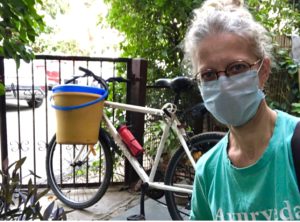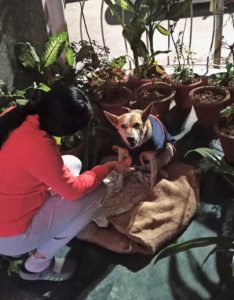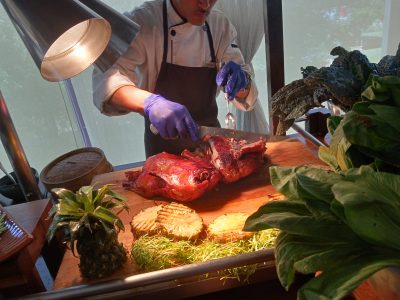An Indian-Dutch woman, Annelieke, has developed an effective stray dog management model in South Delhi, which can be replicated by others
Stray dogs are the silent sufferers during the pandemic. The economic life of the city came to a halt and with it the ecosystem of their survival in the urban habitat was affected. Herds of dogs were forced to migrate to newer areas in search for food, and being territorial animals — that led to infighting and general aggression. Many were starving.
There were very few who were aware of the predicament of the oldest friends of humanity—dogs, let alone support them. Annelieke, or Anna—as she’s known among friends—is a resident of Saket in South Delhi, who came to their rescue. In the process, she developed a “stepwise approach to live in harmony with their community strays,” as she herself puts it.
A native of the Netherlands, Anna, is an Indian citizen now, with a background in the fields of administrative law, public policy and public management. She facilitates multi-stakeholder processes with government, civil society, companies, researchers and financial institutes to jointly work towards water security, biodiversity conservation and management of other natural resources.
She describes herself as a “small village” person who now lives in one of the biggest metropolises in the world. “Living in balance and harmony with nature in urban settings and coexisting with all living beings around us – especially stray dogs – is my personal motto,” she puts it eloquently.

The process of developing and implementing the stepwise approach to live in harmony with community strays dogs has had its share of challenges. Many in the neighbourhood didn’t like her feeding dogs. Anna had to face a backlash. Some twenty residents signed a petition against her, had gathered outside her protesting, and had even filed a police complaint. She invited them inside her house for a conversation. “I took a sympathetic approach,” she summed up.
Awareness is important for any social change to happen. Her advice is that if you can’t be friendly to a dog, at least try not to be aggressive towards them—for they reciprocate your behaviour to you. “Society can benefit a lot—dogs get rid of rodents, pests—burrowing animals, and are stress busters and great companions,” says Anna.
They are good for security; they accompany security guards during their night patrol and make them feel safe with their company. They can be trained as guard dogs—chasing the thieves or raising the alarm if there’s any suspicious activity during the night.
Anna is not in denial. She acknowledges the flipside to the story as well. Stray dogs could be a menace too, if their numbers rise in an unregulated fashion. Rabies is a deadly disease quite common in India—is also caused by monkeys, not just dogs.
That makes the management of stray dogs imperative. She has been doing so in a planned way for many years but last week the Delhi High Court (DHC) order lent support to her kind of community approach involving residents. DHC asserted that the animals have a right under law to be treated with compassion, respect and dignity and that it was the moral responsibility of each and every citizen to protect the animals.

Further, DHC directed the Animal Welfare Board of India (AWBI) to designate areas in consultation with RWAs for feeding of community dogs in the national capital and to facilitate, also to ensure that every RWA constitutes an Animal Welfare Committee. “Community dogs (stray/street dogs) have the right to food and citizens have the right to feed community dogs but in exercising this right, care and caution should be taken to ensure that it does not impinge upon the rights of others or cause any harm, hindrance, harassment and nuisance to other individuals or members of the society,” said Justice J.R Midha.
Dogs are very intelligent and sensitive; understanding their psychology is important to understand why they end up doing things that they do. “They are like a naughty child of three years, and can remember and respond to as many as 300 words,” Anna gives a perspective to a better understanding of a dog.
Her stepwise approach involves feeding dogs by a person–the feeder, addressing them by their names, vaccination makes them safe, sterilization ensures zero puppies—also checks the growth in their numbers. They become happy community dogs. The feeder is the most important link between the animals and society—they facilitate dogs getting sterilised and vaccinated.
A small group of volunteers, a committee of students, under the guidance of Anna implemented it and carried out awareness. Some of the issues addressed were ‘how to avoid stray dog confrontation?’ or for that matter ‘understanding dog language.’ One of the volunteers is a 15-years-old, Prachi Gowda, a student of class 11, explains that the dogs were aggressive because they were hungry and forced out of their territory during the pandemic. She is also involved in documentation of the community dogs—gender-wise. “Things have changed a bit. Though, I feel bringing a change is very difficult—especially when it comes to the mindset,” she added.
Despite the local resistance, they were able to prepare a record of all the dogs with their pictures, each of them given a name and they responded to the name. “It’s like a Facebook of dogs,” Anna draws a parallel.
Anna wants to put it online. “This is a good way to share the tools I developed, it will be open source.” An Indian residing in Canada is helping a Delhi-based Dutch-Indian woman to make a website www.straybuddy.in “where the community stray dog approach and tools will be published and can be downloaded by anyone who wants to do the same in their neighbourhood,” she adds. And that’s what the DHC has directed.
Dogs are lucky that people like Anna are doing their best to make their life better and to make public places safe for both humans and animals—dogs in particular. Anna considers herself lucky “to be here in Delhi as it’s an opportunity to take care of dogs.”
That’s not all, dogs provide the reason to connect with people at large. Thanks to her initiatives, “I get to know the neighbours and not just dogs,” she quips.
(Cover: Julie, happy community dog)





